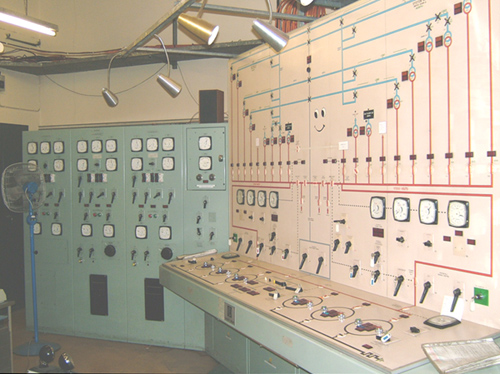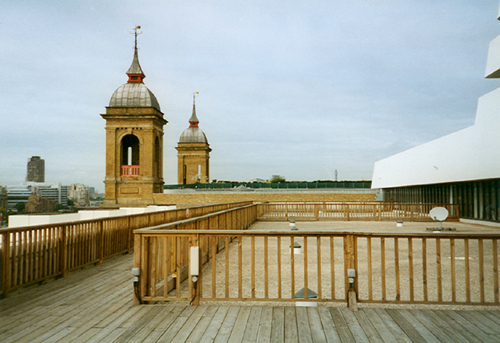The Cooling Pods
 |
This photo shows the six cooling pods which housed the radiators for the standby generators which were installed in the basement levels. The cooling pods were one of the unique design elements which gave the impression of a 'working building' rather than simply a boring office space! |
Although there were 6 pods, the ones at each end were not used as only 4 engines (and hence radiators) were actually installed.
The Standby Power
As an operational building, Mondial was equipped with a full capacity standby power set up:
 |
"There were 4 diesel engines, each connected to a generator capable of supplying 2.2 MW of power at 11kV. The engines would start automatically and connect to the building load in the event of a mains failure. |
 |
The engine and power control room. This also shows the building's electrical distribution layout. |
Large exchanges (and other buildings) usually have an 11kV (11,000 volts) power supply and/or generating set up. This is mainly for economic reasons as there is less power loss in distribution, at a higher voltage, and therefore smaller sized cables can be used.
Power is directly related to voltage and current: power (watts) = voltage (volts) x current (amps). [W= V* A]
If you increase the voltage, the current will go down, but the power produced will remain the same. So with a low current we can have smaller cables. This is why the national grid network operates at 132kV and the 'supergrid' between 275kV and 400kV.
Other Services
Also in the basement were the diesel oil fuel tanks. There was a total storage capacity of 800,000 litres, which was enough reserve to keep the building powered for several months if necessary. In practice they never needed to run for this length of time. The building's central cooling plant was located in the basement and the condensers were water cooled. The cooling towers were located on the 8th floor roof area.
 |
In this photo, the step-back design is very noticeable with some distance between the cooling pods on the left and the upper part of the building on the right. On the far horizon, in line of sight is the Post Office Tower. |
An Openreach engineer who was involved in the building closure programme adds...
"My pictures of the generators got lost. A great shame as these were impressive machines. There were four of these beasts, each being nearly the size of a single decker bus. Looking inside the crankcase revealed the underside of the 16 cylinders, each cylinder being the size of a household bucket. The whole of subfloor 2 south side was a power station in itself. Also in my travels snooping around during recovery, subfloor 2 north side held two water storage tanks (I am assuming water) each being the size of a two storey detached house! As for the air con and chiller equipment....!!!! It seemed that nothing in Mondial was small."
All logos and trade marks are the property of their respective owners and are used on the Light Straw site(s) for review only. Students and researchers are recommended to make their own independent enquiries as to the accuracy of the information contained therein.